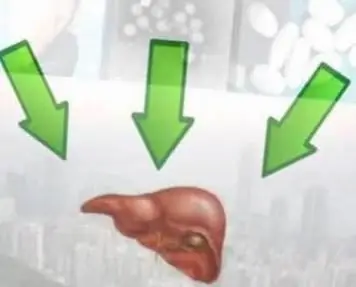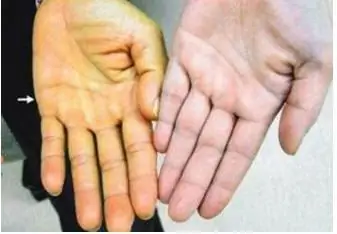- Author Curtis Blomfield [email protected].
- Public 2023-12-16 20:44.
- Last modified 2025-01-23 17:01.
Toxic damage to the liver is understood as pathological structural changes in tissue (reversible and irreversible) under the influence of damaging chemicals. The ICD 10 code for toxic hepatitis is K71.
Etiology
The causes of chronic hepatitis are: drugs, alcohol, household, vegetable and industrial poisons.

- Drug toxic liver injury. Symptoms may occur with a single large dose or long-term use of small cumulative doses of certain drugs. For example, when using Tetracycline, Paracetamol. Some substances can inhibit hepatocyte enzymes. These are, for example: "Erythromycin", "Rifampicin", "Clarithromycin", alcohol, smoking, antifungal and antiretroviral drugs, penicillins. Also, such antiepileptic substances have a toxic effect: "Oxacillin", "Flucloxacillin", "Amoxicillin", "Clavulonate"("Amoxiclav"), sulfonamides, "Co-trimaxazole", "Sulfosalazine", "Nifurantoin", "Isoniaid", "Tubazid", "Ftivazid", anticonvulsants. The general code for ICD 10 for toxic hepatitis of drug genesis is K71. Further, it is designated depending on the morphological changes in the organ.
- Alcohol, drugs. The general code for ICD 10 for toxic hepatitis of alcoholic origin is K70.
- Industrial poisons. Pesticides, arsenic, phosphorus, insecticides, phenols, aldehydes, chlorinated hydrocarbons, etc.
- Plant poisons. Gorchak, ragwort, mushroom poisons, etc. The general ICD 10 code for toxic hepatitis caused by chemical or vegetable poisons is also K71.

Pathogenesis
One of the functions of the liver is a barrier. It neutralizes a poisonous chemical into an inactive form.
- When a hepatotoxic substance enters the body, active metabolites are formed in the liver, which can have a direct toxic effect on the cell or an immune-mediated one (determined by the mechanism of hypersensitivity). Both of these processes cause cytolysis, necrosis of the hepatocyte. Acute or chronic hepatitis develops.
- Also, drugs and their metabolites can reduce mitochondrial oxidation in the cell and transfer the metabolism in it to the anaerobic pathway. The synthesis of low-density lipoproteins is disrupted, and triglycerides accumulate in the hepatocyte. The patient develops fatty degenerationliver. A large number of fatty inclusions in the cell leads to its steatonecrosis.
- The functions of enzymes and transport proteins in the cell can also be disrupted without damage to the hepatocyte itself, hyperbilirubinemia and an increase in gamma-glutamyl transferase occur. Other liver function tests do not change.
- Blockade of transport enzymes, damage to hepatocytes cause cholestasis, impaired synthesis or transport of bile. Bile is formed in the hepatocyte from bile acids, bilirubin, and cholesterol. Then it enters the bile duct. Intrahepatic cholestasis is intralobular and extralobular. There is also extrahepatic cholestasis, characterized by obstruction of bile flow in the extrahepatic bile ducts.
Thus, a toxic substance can cause acute liver damage with massive death of hepatocytes and chronic - with repeated intake of small doses of a toxic substance.
- With necrosis of hepatocytes without the occurrence of autoimmune processes and cholestasis, AST, ALT will be increased.
- If hepatocellular cholestasis joins, then there is a rise to 2 norms of alkaline phosphatase, ALT, AST, GGTP.
- In ductular cholestasis with cell necrosis, the picture is the same, but ALP increases by more than 2 norms.
- In autoimmune processes, an increase in immunoglobulins by more than 1.5 times is added.
Clinic
If liver toxicity has occurred, symptoms can develop both acutely and slowly (chronically). The patient complains of pain and heaviness in the right hypochondrium, nausea, lack ofappetite, weakness. There may be itching of the skin, loose stools, bleeding. The patient is retarded. On examination, the skin and sclera are icteric. With cholestasis, the color of the urine darkens, the feces become light. There is an enlargement of the liver and spleen. Possible ascites, fever. Symptoms of toxic hepatitis and treatment depend on the activity of the inflammatory process.

Diagnosis
If toxic hepatitis is suspected, the diagnosis is made on the basis of clinical, anamnestic, laboratory, and instrumental data. A general blood and urine test, a biochemical analysis are prescribed: liver tests, protein levels, coagulation system, lipidogram are examined. An analysis for immunoglobulins, ultrasound of the abdominal organs, endoscopy, MRI, liver biopsy is also prescribed.
Treatment
The main drugs used to treat liver damage include:
- Ursodeoxycholic acid UDCA ("Ursofalk", "Ursosan", "Ursodez"). It reduces cholestasis (bile stasis), enhances the excretion of bile acids, has a membrane-stabilizing effect (protection of the cell wall from exposure to toxins), as well as hepatoprotective, immunomodulatory, anti-inflammatory (prednisolone-like), hypocholesterolemic, anti-apoptotic (slowing down the aging of hepatocytes), litholytic (dissolves cholesterol stones). with cholelithiasis), antifibrotic (slows down the progress of cirrhosis, prevents its occurrence), cardioprotective, increases insulin sensitivity, improves metabolismlipids and glucose in the liver, acts as a vasodilator.
- Essential phospholipids ("Essentiale") restore the integrity of cell membranes, have an antifibrotic effect.
- S-ademeteonin ("Heptral") increases the amount of substances in the cell that fight toxins, reduces cholestasis and lipid peroxidation.
- Preparations "Alpha" lipoic acid ("Berlition", "Thioctacid") fight the development of liver steatosis.
- Artichoke preparations have a choleretic effect.
- Silymarin preparations ("Karsil", "Legalon") have a direct antifibrotic effect.


Assignment algorithm
So what is toxic hepatitis? Symptoms and treatment what are it? Let's add some clarifications. According to clinical recommendations for toxic hepatitis, if GGTP, alkaline phosphatase are elevated (there is cholestasis), and AST and ALT are normal or rise no higher than two norms, then UDCA is prescribed at a dose of 15 mg per kg (750 - 1000 mg per day for two doses) for three months or more. If more than two norms (3 - 5), then "Heptral" is added intravenously at 400 - 800 mg daily for 10 - 15 days.
With a normal level of alkaline phosphatase (no cholestasis) and an increase in ALT and AST up to 5 norms, UDCA 10 mg per kg is prescribed. Appointed for 2-3 months "Essentiale", "Berlition" depending on the causes of the disease.
If AST, ALT, bilirubin morethan 5 norms, then glucocorticoids are added. "Prednisolone" is prescribed intravenously up to 300 mg per day for up to 5 days, with subsequent transfer to tablets and a gradual decrease in dose. UDCA and "Heptral" are prescribed according to the scheme above (where alkaline phosphatase is increased). Plus vitamins B1, B12, B6, PP are needed.






